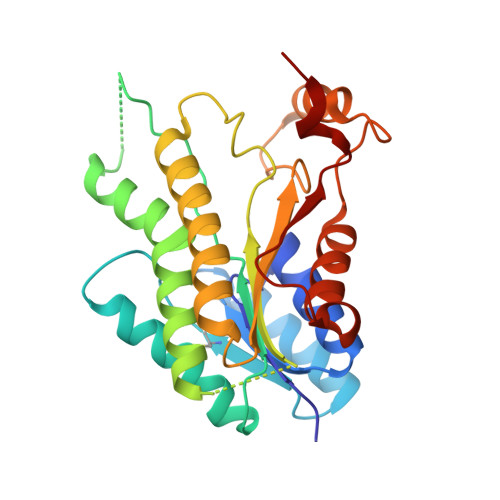One Scaffold, Three Binding Modes: Novel and Selective Pteridine Reductase 1 Inhibitors Derived from Fragment Hits Discovered by Virtual Screening.
Mpamhanga, C.P., Spinks, D., Tulloch, L.B., Shanks, E.J., Robinson, D.A., Collie, I.T., Fairlamb, A.H., Wyatt, P.G., Frearson, J.A., Hunter, W.N., Gilbert, I.H., Brenk, R.(2009) J Med Chem 52: 4454
- PubMed: 19527033
- DOI: https://doi.org/10.1021/jm900414x
- Primary Citation of Related Structures:
2WD7, 2WD8, 3GN1, 3GN2 - PubMed Abstract:
The enzyme pteridine reductase 1 (PTR1) is a potential target for new compounds to treat human African trypanosomiasis. A virtual screening campaign for fragments inhibiting PTR1 was carried out. Two novel chemical series were identified containing aminobenzothiazole and aminobenzimidazole scaffolds, respectively. One of the hits (2-amino-6-chloro-benzimidazole) was subjected to crystal structure analysis and a high resolution crystal structure in complex with PTR1 was obtained, confirming the predicted binding mode. However, the crystal structures of two analogues (2-amino-benzimidazole and 1-(3,4-dichloro-benzyl)-2-amino-benzimidazole) in complex with PTR1 revealed two alternative binding modes. In these complexes, previously unobserved protein movements and water-mediated protein-ligand contacts occurred, which prohibited a correct prediction of the binding modes. On the basis of the alternative binding mode of 1-(3,4-dichloro-benzyl)-2-amino-benzimidazole, derivatives were designed and selective PTR1 inhibitors with low nanomolar potency and favorable physicochemical properties were obtained.
- Division of Biological Chemistry and Drug Discovery, College of Life Sciences, University of Dundee, Dundee DD1 5EH, UK.
Organizational Affiliation:




















